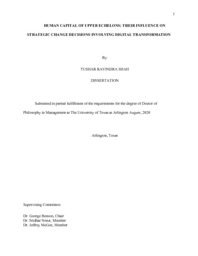
ATTENTION: The works hosted here are being migrated to a new repository that will consolidate resources, improve discoverability, and better show UTA's research impact on the global community. We will update authors as the migration progresses. Please see MavMatrix for more information.
Show simple item record
| dc.contributor.advisor | Benson, George | |
| dc.creator | Shah, Tushar R | |
| dc.date.accessioned | 2022-08-24T15:16:25Z | |
| dc.date.available | 2022-08-24T15:16:25Z | |
| dc.date.created | 2020-08 | |
| dc.date.issued | 2020-09-04 | |
| dc.date.submitted | August 2020 | |
| dc.identifier.uri | http://hdl.handle.net/10106/30893 | |
| dc.description.abstract | My dissertation studies strategic change in the context of digital transformation and the role of organization’s upper echelons (specifically the human capital of TMTs and CEOs) in predicting digital transformation. I concur with the prevalent belief that digital transformation is the fourth industrial revolution. It is already disrupting several businesses and business models as a result of which existing models of strategic change may have to be modified to explain these drastic transformations. I begin with defining the domain of strategic change as experienced by organizations when they intend to or are undergoing digital transformation. To support my theoretical assertions, I use upper echelons theory, multi-lens model of strategic change and dynamic capabilities perspective, in combination with human capital literature. Using text analytics, I empirically derive a measure for digital transformation. I then test some of my hypotheses related to different human capital characteristics of top management team members and CEOs of the top 500 organizations as per S&P 500 rankings. I also examine the moderating influence of environmental dynamism in the relationship between upper echelons characteristics and strategic change related to digital transformation. I run two different models using multilevel (hierarchical) linear regression and present a composite picture of my findings. I find that TMT role heterogeneity is positively related to digital transformation. This relationship is moderated such that at high dynamism, it remains positive whereas for low dynamism it becomes non-significant. I further find that digital transformation follows an inverse U‐shaped curvilinear relationship with TMT mean tenure such that it is lowest at low and high levels of TMT mean tenure. In moderating conditions, this relationship’s magnitude increases under low dynamism but becomes non-significant under high dynamism. CEO duality is negatively associated whereas CEO share-owning is positively associated with digital transformation, and finally CEO tenure is negatively associated with digital transformation under low dynamism but non-significant at high dynamism.
My main proposed contribution to literature is to supplement the existing models of strategic change in the context of technological changes in organizations. Secondly, I use some unique methods and techniques to define the term digital transformation. | |
| dc.format.mimetype | application/pdf | |
| dc.language.iso | en_US | |
| dc.subject | Digital Transformation, Upper Echelons, TMT, CEO, Text Analytics, Strategic Change | |
| dc.title | Shah-Dissertation2020-HumanCapitalOfUpperEchelons | |
| dc.type | Thesis | |
| dc.degree.department | Management | |
| dc.degree.name | Doctor of Philosophy in Management | |
| dc.date.updated | 2022-08-24T15:16:25Z | |
| thesis.degree.department | Management | |
| thesis.degree.grantor | The University of Texas at Arlington | |
| thesis.degree.level | Doctoral | |
| thesis.degree.name | Doctor of Philosophy in Management | |
| dc.type.material | text | |
| dc.creator.orcid | 0000-0001-8317-9074 | |
Files in this item
- Name:
- SHAH-DISSERTATION-2020.pdf
- Size:
- 5.781Mb
- Format:
- PDF
This item appears in the following Collection(s)
Show simple item record


